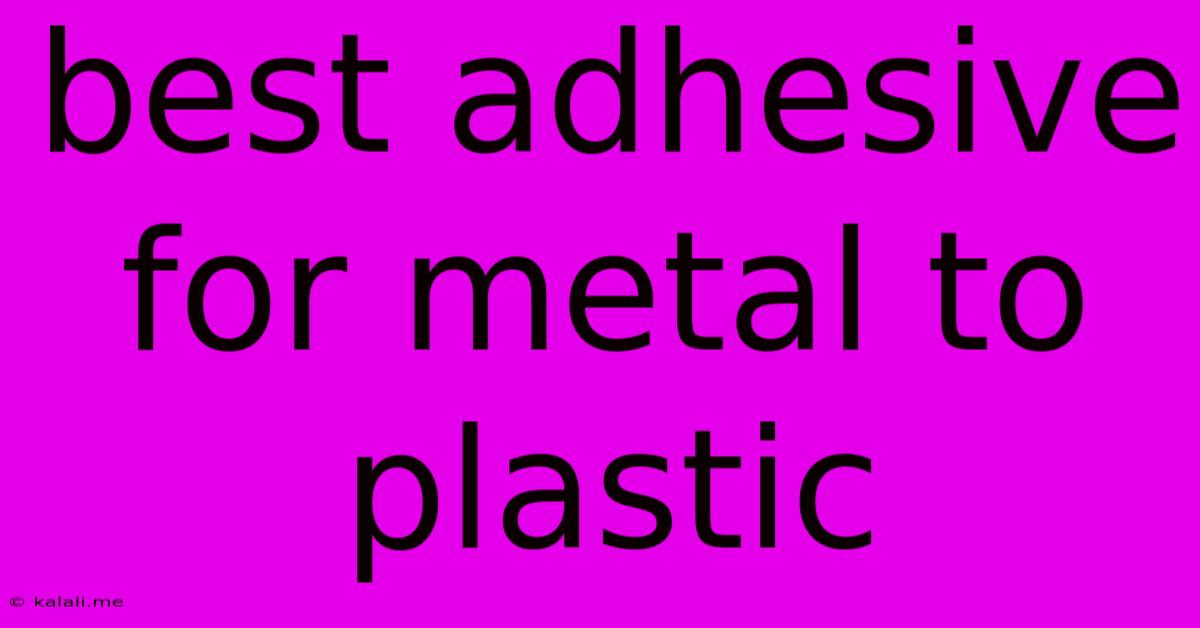Best Adhesive For Metal To Plastic
Kalali
Jun 05, 2025 · 3 min read

Table of Contents
Finding the Best Adhesive for Metal to Plastic: A Comprehensive Guide
Choosing the right adhesive for bonding metal to plastic can be tricky. The success of your project hinges on selecting an adhesive that accounts for the different properties of these materials, ensuring a strong, long-lasting bond. This guide will delve into the various adhesive types, their strengths and weaknesses, and ultimately help you choose the best adhesive for your specific needs. Understanding the surfaces you're working with—the types of metal and plastic—is crucial for selecting the most effective adhesive.
Understanding the Challenges of Metal-to-Plastic Bonding
Metal and plastic possess significantly different surface properties. Metals are often denser and more rigid, while plastics are more flexible and can have varying levels of porosity. This difference in surface energy often leads to poor adhesion unless the right adhesive and surface preparation techniques are employed. The adhesive needs to create a strong mechanical and chemical bond, overcoming the inherent challenges of dissimilar material surfaces.
Types of Adhesives for Metal to Plastic
Several adhesive types are suitable for bonding metal to plastic, each with its own set of advantages and disadvantages:
1. Epoxy Adhesives: Epoxies are a popular choice due to their versatility, high strength, and good resistance to chemicals and environmental factors. They are two-part adhesives, requiring mixing before application, and offer excellent gap-filling capabilities. However, curing time can be relatively long, and they can be more expensive than other options. Consider using epoxy for applications requiring high strength and durability.
2. Cyanoacrylate (Super Glue): Cyanoacrylates, commonly known as super glue, are known for their incredibly fast curing time. They are easy to use and create a strong bond on many surfaces. However, they are less forgiving of surface imperfections and may not be as durable as epoxy for applications subjected to high stress or extreme temperatures. Ideal for quick repairs and smaller projects where high strength isn't paramount.
3. Urethane Adhesives: Urethanes offer a good balance of strength, flexibility, and durability. They are often preferred for applications where some flexibility is needed, making them suitable for bonding dissimilar materials that may experience some movement or vibration. A good choice for applications requiring both strength and flexibility.
4. Acrylic Adhesives: Acrylic adhesives provide excellent adhesion to various surfaces, including metals and plastics. They tend to be more impact resistant compared to cyanoacrylates, offering good strength and durability. Many acrylic adhesives are solvent-based, so proper ventilation is important during application and curing. Suitable for a wide range of applications, offering a balance of strength and ease of use.
Factors to Consider When Choosing an Adhesive
Several factors influence the selection of the best adhesive for your specific metal-to-plastic bonding project:
- Strength Required: High-stress applications demand high-strength adhesives like epoxies.
- Temperature Resistance: Consider the operating temperature range of your application. Some adhesives are better suited for high or low temperatures.
- Chemical Resistance: Will the bond be exposed to chemicals or solvents? Choose an adhesive with the appropriate chemical resistance.
- Curing Time: Consider the project's timeline. Fast-curing cyanoacrylates are ideal for quick repairs, while epoxies require more time to cure fully.
- Gap-Filling Capabilities: Epoxies are excellent gap-fillers, while other adhesives may require close-fitting surfaces.
- Surface Preparation: Thorough surface preparation is crucial for optimal adhesion regardless of the adhesive type. Cleaning and possibly roughening the surfaces will ensure a stronger bond.
Surface Preparation: A Crucial Step
Regardless of the adhesive chosen, proper surface preparation is essential. This typically involves:
- Cleaning: Remove dirt, grease, oil, and other contaminants from both the metal and plastic surfaces using a suitable solvent.
- Roughening: For some materials, it may be beneficial to lightly roughen the surfaces to increase surface area and improve adhesion. This can be done with sandpaper or a suitable abrasive.
By carefully considering the factors outlined above and choosing the appropriate adhesive and surface preparation techniques, you can ensure a strong, reliable bond between metal and plastic components. Remember, always test a small area before applying the adhesive to the entire surface to verify compatibility and ensure optimal results.
Latest Posts
Latest Posts
-
Can You Put Nylon Strings On A Steel String Guitar
Jun 07, 2025
-
Error Check The Imgur Imgchest Link Or The Syntax
Jun 07, 2025
-
Do All Spouses In Skyrim Open A Store
Jun 07, 2025
-
Last Names That Start With Mc
Jun 07, 2025
-
All Rational Numbers Are Whole Numbers
Jun 07, 2025
Related Post
Thank you for visiting our website which covers about Best Adhesive For Metal To Plastic . We hope the information provided has been useful to you. Feel free to contact us if you have any questions or need further assistance. See you next time and don't miss to bookmark.